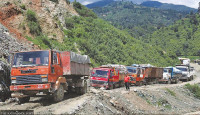Wed, Nov 5, 2025
Opinion
No monkeying around
Proper planning is required to mitigate conflict between wild animals and people
bookmark
Min Raj Dhakal
Published at : November 19, 2018
Updated at : November 19, 2018 07:43
Mitigating conflict between parks and people has been a global challenge for both conservation scientists and policy-makers. Incidents of wild animals wandering into human settlements are increasing even outside buffer zone areas. These intrusions frequently result in a vast damage of agricultural crops and shelters, affecting farmers’ livelihood and sometimes even leading to human casualties. Elephants are especially problematic in Nepal. The seriousness of the problem was indicated by pledges made during the last parliamentary election; candidates of the affected areas used pledges to chase elephants from human settlement areas as an electoral strategy. Such cases warrant a paradigm shift regarding the philosophy and politics underlying present day conservation strategies.
Compensation is a common practice proscribed by activists and leaders who do not survive on forest products. When a farmer’s yearly earning is destroyed by the wild, crop compensation only provides short term relief. Money, even in millions, can never compensate for the lives lost from animal attacks. In a country where an increase in agricultural production is needed, crop compensation is also not a sustainable solution. For many conservation activists, public awareness is a fundamental part of the solution. Familiarity with animal behavior helps people of buffer zones enter the forest for their basic needs but expensive awareness campaigns have done little to prevent people from attacks in the wild. Fewer cases of retaliatory killings and backlash against conservation movements indicate that the general public is conscious about the value of conservation. In many places, local communities have demonstrated their commitment to acting as participants and partners in conservation attempts.
Furthermore, crop rotations and changing crops to species that are unpalatable to the wild can only be a temporary relief to the farmers. Recent reports of the problem of monkeys in Parbat continue to pose real challenges and exemplifies how crop rotations often are not viable solutions.
Electrical fences are also sometimes used to deter elephants. Such attempts either lead to the death of the animal or causes agitations, ultimately causing animals to simply change their route to create problems in another area. When the population of a particular animal rises in a protected area, some of them are often transferred to a new area where the number of that animal is limited. While this is an effective solution in the short-term, there are chances that within a few years, the population of the species will increase, creating similar problems in the new area; the problem is simply transferred with the animals themselves.
Wild animals usually have a defined territory within which they limit their activities. If a leopard decides to venture into a house in Bhaktapur or a Rhino walks on the market street in Chitwan, we need a serious re-thinking on strategies related to conservation planning. The concept of respecting the carrying capacity of protected areas is often neglected. Many of the protected areas in Nepal might have animal populations that are well below the maximum number that the area can support. Then a new question arises: why do the animals cross their territory often beyond the buffer zone area? The answer is simple: mainly in search of food. To ensure the survival of a carnivores, enough herbivores are needed; to support these herbivores, enough fodder needs to be available. Issues such as the intrusion of exotic weed species like Mikania, which is an ongoing problem in Chitwan National Park, further hinders mitigation strategies.
Proper management plans to maintain an appropriate population of each species in the food chain and the food web—with assurance that these numbers are within the carrying capacity of the area—seems to be the best solution. Decreasing numbers of predator species and the recently reported deaths of Rhinos indicate weaknesses in habitat management. Enticed by the economic gains of tourism and the incoming financial aid opportunities, the demands for more protected areas are increasing without consideration of the need and carrying capacity of these areas. Strategies need to be formulated based neither on the sentimental love of the wild nor on mere economic concerns.
Developmental activities sometimes demand construction work inside protected areas. Sometimes, simply providing a corridor and roaming area for the wild may solve the problem. But many times, we have to work on a priority-basis and we are therefore minimally affected by our sentimental love for the animal or by economic considerations. Factual observations of conservation scientists need to be considered instead of solely relying on the opinions of conservation activists or political leaders.
Ensuring proper management is a difficult challenge to navigate in and of itself. Elephants cover such a large territory that they pose a real problem to human beings who need the same territory for themselves. Providing a large corridor to cover their range of movement not only demands proper planning but also requires a well-researched understanding of local land-use patterns. Nevertheless, no matter what method we choose, it is important that we reduce the amount of blame we routinely subject to the public for their lack of awareness and instead, focus on proper planning, strategy and management.
Dhakal is a retired professor of botany.
Editor's Picks
E-PAPER | November 05, 2025
×




 21.12°C Kathmandu
21.12°C Kathmandu










